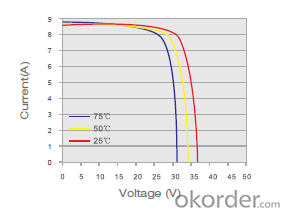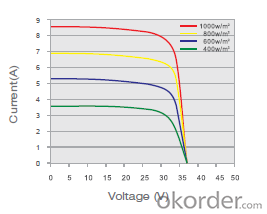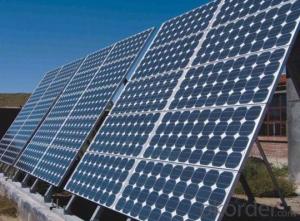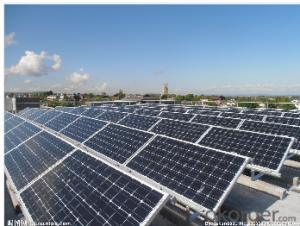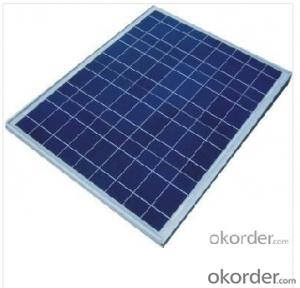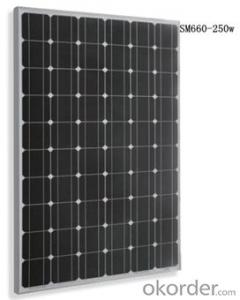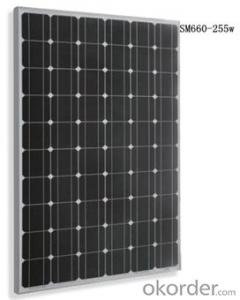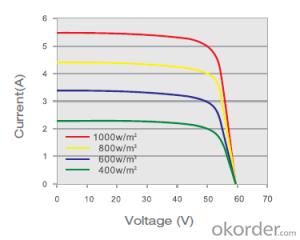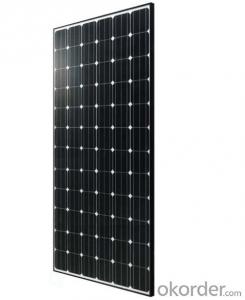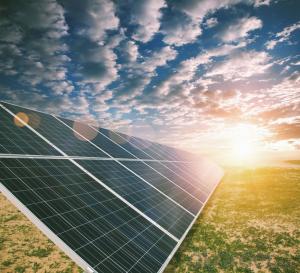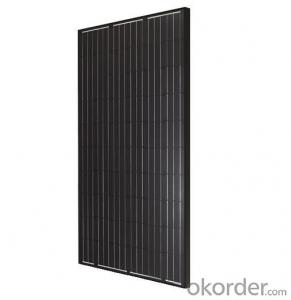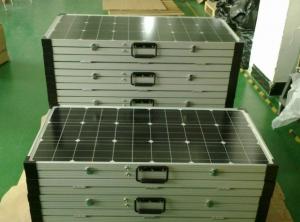SM660-260W Monocrystalline Solar Panels Milwaukee
- Loading Port:
- Shanghai
- Payment Terms:
- TT OR LC
- Min Order Qty:
- 25 set
- Supply Capability:
- 8000 set/month
OKorder Service Pledge
OKorder Financial Service
You Might Also Like
Product Description:
1.Structure of Monocrystalline Solar Module SM660-260w Series Description:
Monocrystalline Solar Module SM660-260w: High efficiency crystalline solar cell. Even if under the weak light, the solar module can produce maximum power output.
II Tempered glass (toughened glass): Anti-reflecting coating and high transmission rate glass increase the power output and mechanical strength of solar module.
III EVA and TPT: Using high quality EVA and TPT to prevent destroying and water.
IV AI frame: Without screw, rner connection. 6 holes on the frame can be installed easily.
V Junction box: Multi function junction box with water proof.
VI Long lifetime: ≥25 years; Less power decrease.
VII Good performance of preventing from atrocious weather such as wind and hails.
VIII Resisting moisture and etching effectively, not effected by geology.
IX The certificate issued by international authority: TUV, IEC, CE.ISO9001.MCS
2. Characteristics of Monocrystalline Silicon Solar Panel:
• Guaranteed tolerance +3%
• High manufacture standards
• Reliable power output
• High module efficiency
• Module efficiency up to 15.5%
• Cells efficiency up to 17.6%
• Strong compressive strength
• Certified to withstand high wind of 2400Pa
3. Standard Test Conditions of Monocrystalline Silicon Solar Panel:
The opto-electrical specifications shown below are stabilized values being measured at Standard Test Conditions, Irradiance: 1000W/m2, Spectrum: AM1.5 at 25°C, The info below is subject to manufacturing tolerances. Where appropriate minutes of measurement are available and are used for the dimensioning of the installation.
Advantages of Polycrystalline Silicon Solar Panel
• 25 year transferrable power output warranty: 10 years / 90%, 25 years / 80%*
• 12 year material and workmanship warranty
• Timeliness of delivery
• Quality Products certified (TUV, IEC, CE.ISO9001.MCS)
4. Solar Panel Images
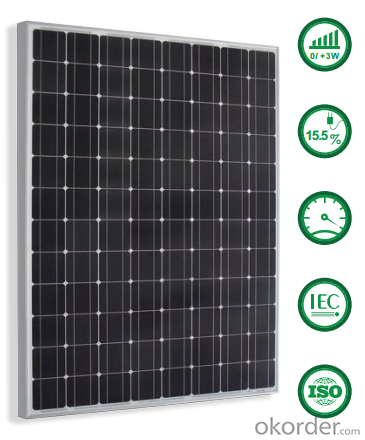
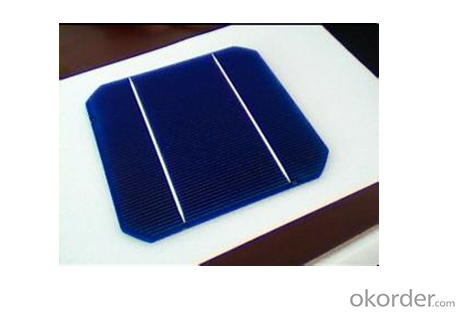


5. Monocrystalline Silicon Solar Panel Specification
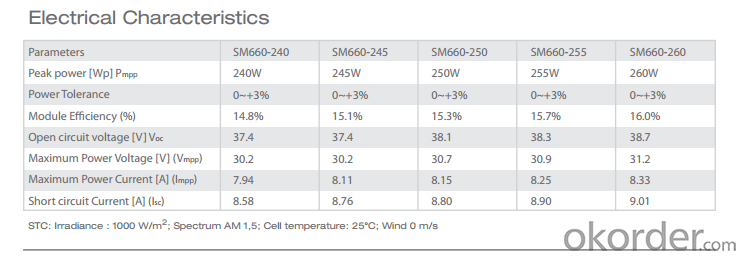
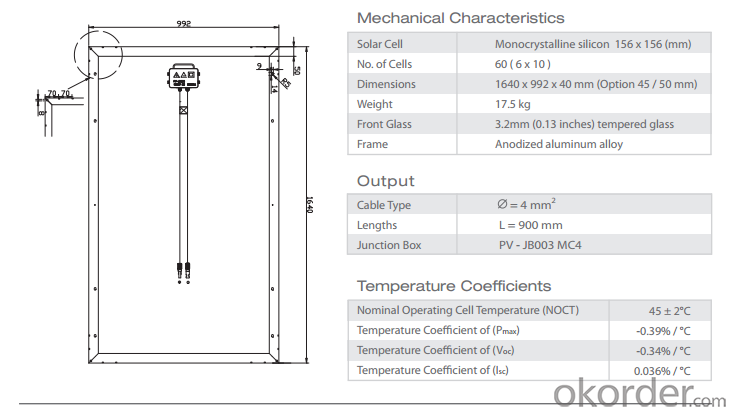


6.FAQ
We have organized several common questions for our clients,may help you sincerely:
①How about your company?
We are a private-owned high-tech company who specializes in developing, manufacturing and marketing of silicon ingots, solar wafer, solar cells, solar modules, PV systems and solar applications products.
At present, We has one research & development team, whose members are well-known experts in photovoltaic area. We also have advanced production and test equipment.
②How to guarantee the quality of the products?
Our products have been certified by CE, CEC,MCS, IEC61215, IEC61730 and ISO9001.
• 25 year transferrable power output warranty: 10 years / 90%, 25 years / 80%*
• 12 year material and workmanship warranty
• Timeliness of delivery
• Quality Products certified (TUV, IEC, CE.ISO9001.MCS)
③How long can we receive the product after purchase?
In the purchase of product within three working days, We will arrange the factory delivery as soon as possible. The pecific time of receiving is related to the state and position of customers.Commonly 7 to 10 working days can be served.
- Q: What is the principle of solar panels to convert solar energy into electricity?
- scientists have applied solar cells to space technology - communication satellites. At the end of the last century, in the process of human self-reflection, this clean and direct energy form for photovoltaic power generation has become more cordial, Not only in space applications, in many areas also show their talents. Such as: solar garden lights, solar power generation system, the village power supply independent system, photovoltaic pumps (drinking water or irrigation), communication power, oil pipeline cathodic protection,
- Q: I want to make 2V 4.5A solar panel to charge my battery used in my RC car project. I just like to know how should I amplify the current for 4.5A. I need the total circuit diagram. Can anyone help me. Please. I need some affordable methods please.
- The simplest way to use these panels is simply to connect the panel to your battery, with a diode in series to prevent the battery from discharging through the panel (no sunlight condition). Just connect the battery for the required charge time then disconnect it. Full sun is required, no shadows on the solar panel! ---------- .
- Q: Can solar panels be installed on water treatment plants or utilities?
- Yes, solar panels can be installed on water treatment plants or utilities. In fact, many water treatment plants and utilities have started to adopt solar energy as a sustainable and cost-effective solution to power their operations. Solar panels can be installed on the rooftops or open areas of these facilities, helping to generate clean electricity and reduce their carbon footprint.
- Q: Rated in kilowatts, what is the maximum output of one 8 by 0 solar panel? Assume this solar panel is located at the equator for maximum sunlight.
- The world record efficiency for a solar panel is about 42%. At the equator, you can get up to about 000W m^-2. The efficiency of commercial cells tends to range from 0-20%. They're almost all single junction cells, so will never exceed 3% efficiency. To work out your maximum power output, multiply 000 x efficiency (as a decimal) x area covered. So an 8m x 0m solar panel would be 80 square metres. At 5% efficiency its peak output would be 2000W or 2kW. Total energy output will be different, since it won't be maximum power output all the time. In fact, it will more likely generate something like 20% of its maximum theoretical output, since the Sun won't always be overhead (and sometimes it's night!). The 2kW panel above might have a mean output of 2.4kW, or 57.6kWh/day.
- Q: What is the impact of dust and dirt on solar panels' efficiency?
- Dust and dirt on solar panels can significantly reduce their efficiency. When dust accumulates on the surface of the panels, it blocks sunlight from reaching the photovoltaic cells, thereby reducing the amount of electricity generated. The accumulation of dirt can create a barrier that hinders the panels' ability to absorb sunlight effectively. Regular cleaning and maintenance of solar panels are crucial to ensure optimal efficiency and maximize energy production.
- Q: Can solar panels be installed on a library or educational institution?
- Yes, solar panels can be installed on a library or educational institution. In fact, many libraries and educational institutions have already embraced solar energy and installed solar panels on their rooftops or surrounding areas. This helps them reduce their carbon footprint, save on electricity bills, and serve as a sustainable example for the community.
- Q: How much space is needed to install solar panels?
- The amount of space required to install solar panels depends on various factors such as the type of solar panels, their efficiency, and the energy needs of the property. Generally, a typical rooftop solar panel system requires about 100-400 square feet of space for every kilowatt (kW) of solar panels. Additionally, open areas or ground-mounted systems may require more substantial space. It is recommended to consult with a solar installation professional who can assess the specific requirements based on the location and energy goals.
- Q: Can solar panels be damaged by hail or other weather conditions?
- Yes, solar panels can be damaged by hail or other severe weather conditions. Hailstorms can cause physical damage to the panels, resulting in cracks or breakages. Additionally, extreme weather conditions like heavy snowfall or strong winds can also potentially harm the panels. However, modern solar panels are designed to withstand various weather conditions to a certain extent, and many manufacturers offer warranties that cover such damages.
- Q: I'm writing a lab and I have to put information about solar panels in it. The history, who started them, why they are useful etc. any good sites that can help me?
- Yup, just Google solar panel history and away you go.
- Q: I would like to know how much a solar panel would cost for a wingspan of 208 ft for a plane
- That okorder /
Send your message to us
SM660-260W Monocrystalline Solar Panels Milwaukee
- Loading Port:
- Shanghai
- Payment Terms:
- TT OR LC
- Min Order Qty:
- 25 set
- Supply Capability:
- 8000 set/month
OKorder Service Pledge
OKorder Financial Service
Similar products
Hot products
Hot Searches
Related keywords






